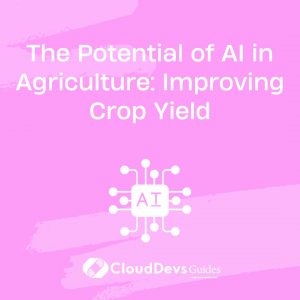The Potential of AI in Agriculture: Improving Crop Yield
In the realm of technology-driven advancements, few fields have experienced such a transformative impact as agriculture. The fusion of artificial intelligence (AI) and agriculture has unlocked a new era of possibilities, promising to reshape the way we cultivate crops and produce food. One of the most significant areas where AI is proving its potential is in improving crop yield. This article delves into the various ways AI is revolutionizing agriculture, from predictive analytics to precision farming techniques, ultimately leading to increased productivity and sustainable practices.
1. The Agricultural Landscape: Challenges and Opportunities
As the global population continues to grow, so does the demand for food. This has put immense pressure on the agricultural industry to produce higher yields to meet the needs of an expanding population. However, this demand coincides with challenges such as climate change, limited arable land, and depleting water resources. Traditional farming methods, while effective, often lack the efficiency required to address these issues adequately.
This is where AI steps in as a game-changer. AI’s ability to process vast amounts of data, recognize patterns, and make informed decisions offers a new approach to tackling these challenges. By harnessing the power of AI, farmers can optimize their practices, increase productivity, and ensure sustainable resource management.
2. Predictive Analytics for Optimal Yield
One of the most exciting applications of AI in agriculture is predictive analytics. By analyzing historical data and real-time information, AI models can forecast various factors that influence crop yield, such as weather patterns, soil quality, and pest infestations. These predictions empower farmers with valuable insights, enabling them to make informed decisions to maximize their yield.
python
# Example code for a simple predictive analytics model
import pandas as pd
from sklearn.linear_model import LinearRegression
# Load and preprocess data
data = pd.read_csv('crop_data.csv')
X = data[['temperature', 'humidity', 'rainfall']]
y = data['yield']
# Train the model
model = LinearRegression()
model.fit(X, y)
# Predict yield based on new data
new_data = pd.DataFrame([[28, 75, 120]])
predicted_yield = model.predict(new_data)
print("Predicted Yield:", predicted_yield[0])
3. Precision Farming: Targeted and Efficient Practices
Precision farming is another area where AI shines. Traditional farming methods often treat fields uniformly, disregarding variations in soil quality and other factors. Precision farming, on the other hand, leverages AI and technology to create a more customized approach. By deploying sensors, drones, and satellite imagery, farmers can collect data about their fields’ specific conditions.
AI algorithms process this data to create detailed maps that highlight variations in soil moisture, nutrient levels, and more. Armed with this information, farmers can apply fertilizers, pesticides, and irrigation precisely where and when needed, reducing waste and improving overall efficiency.
3.1. Drones for Crop Monitoring
Drones equipped with cameras and sensors have become indispensable tools for precision farming. They can capture high-resolution images of fields, providing real-time insights into crop health and growth. AI algorithms can analyze these images to identify signs of diseases, nutrient deficiencies, or water stress.
python
# Example code for analyzing drone images using AI
import cv2
import numpy as np
def analyze_crop_image(image_path):
# Load the image
image = cv2.imread(image_path)
# Apply image processing techniques
processed_image = some_image_processing_function(image)
# Use an AI model for object detection or disease recognition
results = ai_model.predict(processed_image)
return results
# Analyze a drone image
results = analyze_crop_image('crop_image.jpg')
print(results)
4. Data-Driven Decision Making
The true power of AI in agriculture lies in its ability to transform raw data into actionable insights. By collecting data from various sources such as sensors, drones, and satellites, AI systems can generate comprehensive reports that guide farmers in making critical decisions.
For instance, AI algorithms can analyze historical weather patterns and current conditions to recommend optimal planting and harvesting times. They can also suggest the most suitable crop varieties for specific soil and climate conditions, ensuring higher yields and better resource utilization.
5. Managing Pest and Disease Control
Pests and diseases have long been a significant threat to crop yields. Traditional methods of pest control involve scheduled spraying of pesticides, which can be both costly and harmful to the environment. AI offers a smarter approach.
By using AI-powered sensors and cameras placed in fields, farmers can continuously monitor their crops for signs of pest infestations or diseases. These sensors can detect subtle changes in plant color, growth patterns, and other indicators that may signal a problem. Upon detection, AI algorithms can precisely target affected areas with appropriate interventions, minimizing the need for widespread pesticide use.
python
# Example code for AI-powered pest detection
def detect_pests(image):
# Use AI model to detect pests
pests_detected = ai_model.detect_pests(image)
if pests_detected:
notify_farmers("Pest infestation detected in Field A")
apply_pesticide(target_area="Field A")
else:
print("No pests detected.")
# Capture an image from a pest-monitoring camera
pest_image = capture_image('pest_camera')
detect_pests(pest_image)
6. Towards Sustainable Agriculture
Beyond improving crop yield, AI in agriculture contributes significantly to sustainability. By optimizing resource usage and reducing waste, AI-driven practices align with the goal of environmentally friendly farming.
AI can aid in designing crop rotations that enhance soil health, water management plans that conserve resources, and strategies to minimize post-harvest losses. With AI’s ability to analyze data from multiple sources, farmers can adopt holistic approaches that balance productivity with environmental responsibility.
Conclusion
The marriage of AI and agriculture holds immense promise for boosting crop yield and transforming the industry. From predictive analytics that offer insights into optimal planting conditions to precision farming techniques that maximize resource efficiency, AI is revolutionizing how we approach food production. As technology continues to evolve, AI-powered solutions will play an increasingly vital role in addressing the challenges of a growing global population and a changing climate. By embracing AI’s potential, farmers can ensure not only their own success but also the sustenance of a hungry world.
Table of Contents









